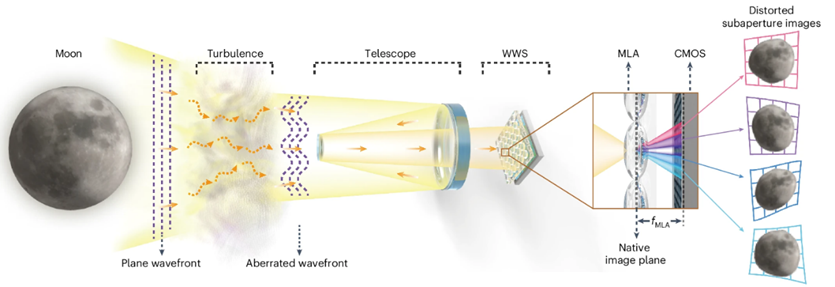In 1964, American physicist Richard Feynman pointed out that "turbulence is one of the most important unsolved problems in classical physics." Atmospheric turbulence, a highly chaotic system, is one of the most elusive forms of turbulence, characterized by extremely high randomness in its motion patterns, making it difficult to model, detect, and predict accurately. The interdisciplinary team of imaging and intelligent technology at Tsinghua University has developed the Wide-field Wavefront Sensor (WISE), achieving real-time detection and prediction of atmospheric turbulence over a range exceeding 1100 arcseconds (diagonal). This imaging technology offers advantages of a large field of view, high resolution, and strong robustness, increasing the sensing range nearly a thousandfold compared to the widely used Shack-Hartmann wavefront sensor. The detection capability of the WISE is equivalent to the combined total of hundreds or thousands of wavefront sensors, and it can be widely applied to existing optical systems, enabling wide-area detection and prediction of atmospheric turbulence, correcting atmospheric turbulence disturbances, and achieving efficient collection and precise reconstruction of large-scale optical signals.

Concept Diagram of the Wide-field Wavefront Sensor Chip for Atmospheric Turbulence(Source: Nature Photonics)
Recently, a related paper titled "Direct Observation of Atmospheric Turbulence with a Video-rate Wide-field Wavefront Sensor" was published in Nature Photonics. The corresponding authors are Professor Lu Fang, Professor Qionghai Dai, and Associate Professor Jiamin Wu from Tsinghua University. The joint first authors are Tsinghua University PhD student Yuduo Guo, undergraduate student Yuhan Hao, and assistant researcher Sen Wan, with participation from postdoctoral researcher Hao Zhang and assistant researcher Laiyu Zhu.

Diagram of the Atmospheric Turbulence Observation System Based on WISE (Source: Nature Photonics)
[1].Guo Y, Hao Y, Wan S, Zhang H, Zhu L, Zhang Y, Wu J, Dai Q, Fang L, Direct Observation of Atmospheric Turbulence with a Video-rate Wide-field Wavefront Sensor. Nature Photonics, 2024. https://doi.org/10.1038/s41566-024-01466-3